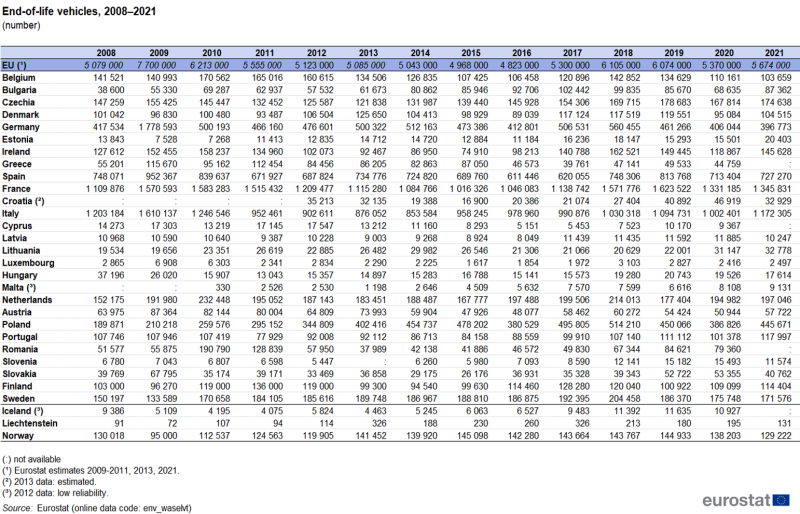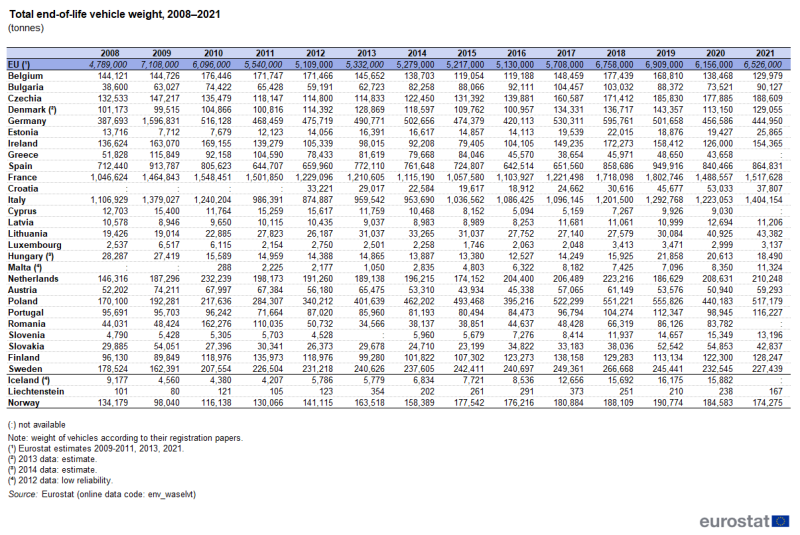End-of-life vehicle statistics
Data extracted in June 2023.
Planned article update: 29 November 2024.
Highlights
The total weight of passenger cars, vans and other light goods vehicles scrapped in the EU in 2021 was 6.5 million tonnes; 93.6 % of the parts and materials were reused and recovered, while 88.1 % were reused and recycled.
Reuse/recovery and reuse/recycling rate for end-of-life vehicles, 2021
This article provides an overview of statistical information on end-of-life vehicles in the European Union over the period 2008-2021. End-of-life vehicles are vehicles that have ended their useful service and are processed as waste, in practice dismantled, shredded or otherwise disposed. During the dismantling phase, spare parts of the vehicle may be separated and reused for repairing vehicles in service (reuse operation). The rest of the dismantled vehicle will undergo recycling operations, be used for producing energy (energy recovery operation) or finally disposed. The data cover end-of-life passenger cars and light goods vehicles such as vans and pick-ups. Information and data are based on Directive 2000/53/EC on End-of-Life Vehicles and Commission Decision 2005/293/EC, which lays down rules on monitoring the reuse/recovery and reuse/recycling of end-of-life vehicles according to the definition of these operations in Directive 2000/53/EC. EU Member States and EEA/EFTA countries yearly report data on the total vehicle weight and number of end-of-life vehicles and rates for 'total reuse and recycling' and 'total reuse and recovery'.
Full article
Number of end-of-life vehicles
The total number of end-of-life vehicles reported in the European Union was estimated at 5.7 million in 2021, an increase of 5.7 % compared with 2020 (see Table 1). After sharp rises from 4.8 million in 2016 to 5.3 million in 2017 and to 6.1 million in 2018, the number of end-of-life vehicles decreased for two consecutive years. The number of end-of-life vehicles observed in 2018 was still well below the peak levels recorded in 2009 (7.7 million). Several countries established short term governmental subsidies for scrapping programs in 2009, in order to incentivise the dismantling of older vehicles during the financial crisis. Three Member States held scrapping schemes in 2008, twelve in 2009 and one in 2010[1].
Compliance with targets on reuse/recycling and reuse/recovery for end-of-life vehicles
Since 2015, EU Member States are required to meet rates of ≥ 85 % for reuse and recycling and of ≥ 95 % for reuse and recovery, by an average of weight per vehicle. The reported rates are shown in Tables 2 and 3. For missing reporting countries, EU aggregates are calculated from available years, applying trend or median estimates.
In 2021, the reuse and recycling rate for end-of-life vehicles in the EU stood at 88.1 %, 1 percentage point lower than in 2020, but 0.8 percentage points higher than in 2018 (see Table 2).
Twenty EU Member States reported reuse and recycling rates of 85.0 % or more in 2021, with another four reporting rates in the range 80.0 %-84.9 %.
Malta reported a reuse and recycling rate of 54.4 % in 2016 and 56.1 % in 2017, as parts of materials arising from de-pollution and dismantling were stored at the site of authorised treatment facilities, pending export for further treatment at favourable market prices and also to limit shipments expenses. Therefore, Malta did not report such materials in any of the tables pursuant to Commission Decision 2005/293/EC. For reference year 2019, Greece reported a rate of 69.7 % due to low price of metal scrap: as in year 2015, this event was causing temporary stocking at the dismantling facilities sites. The rate of 118.8 % reported in 2019 by Poland stems from the treatment at dismantling and shredding sites of stocks of parts of end-of-life vehicles that had not been treated in the previous years.
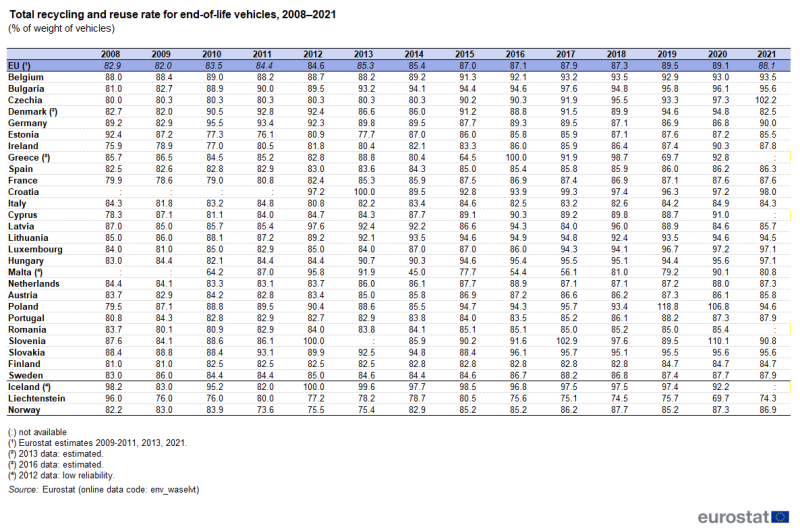
(% of weight of vehicles)
Source: Eurostat (env_waselvt)
The picture is relatively similar for the reuse and recovery rate. The rate for the EU rose from 85.3 % in 2009 to 93.6 % in 2021, although with a decrease of 1.5 percentage points from 2019 to 2021 (see Table 3). Eighteen Member States reported rates above 95.0 % in 2021, with another three Member States reported rates falling in the range 90.0 % to 94.9 %. Three Member States reported rates in the range 80.8 % to 85.8 %.
Due to stocking of materials, as previously explained, Malta reported a rate of 54.4 % in 2016 and 56.1 % in 2017. For reference year 2019, the 77.2 % reported by Greece and the 122.2 % reported by Poland, both outliers, are attributed to the aforementioned reasons. For Denmark, the percentages reported in 2019 and 2020 (above 100 %) could be explained by he fact that more cars were received than were being sent to shredding at scrap-dealers, due to decreases in the stored stocks of vehicles to be scrapped.
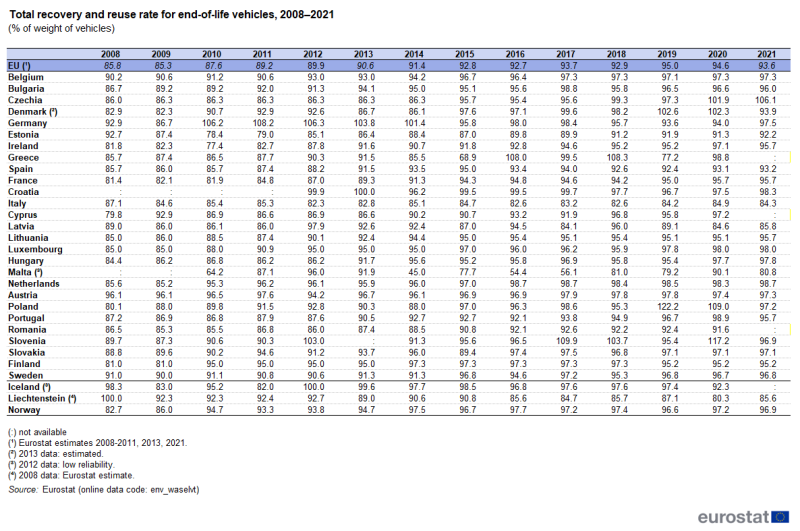
(% of weight of vehicles)
Source: Eurostat (env_waselvt)
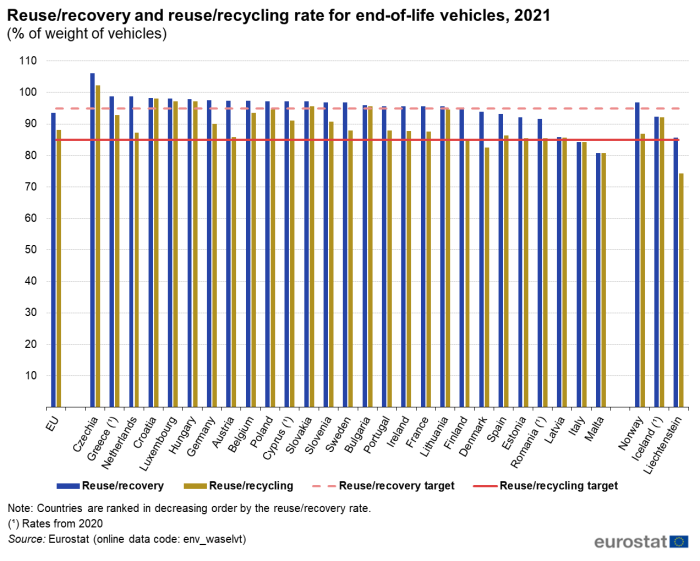
(% of weight of vehicles)
Source: Eurostat (env_waselv)
Total weight of end-of-life vehicles
Two sources can be considered for the total weight of end-of-life vehicles: the total vehicle weight derived from the registration documents or similar, or the sum of the amounts reported for de-pollution and dismantling, shredding and export. These sources do not necessarily match perfectly, but they should show a similar order of magnitude.
In 2021, the end-of-life vehicles in the EU were estimated to have a total vehicle weight of 6.5 million tonnes, according to their registration papers. This amount stayed considerably higher than the 5.7 million tonnes reported in 2017, but fell by 5.5 % compared with 2019 when it was 6.9 million tonnes, the highest volume recorded since the peak in 2009.
The total weight of end-of-life vehicles should be calculated by summing up all the single vehicle weights declared in the registration papers; this total amount is more or less proportional to the number of vehicles being scrapped. Thus, as detailed above, the national scrapping schemes in 2009 and 2010 led to highs in the number of end-of-life vehicles and as a consequence also in the total weight. The total weight of end-of-life vehicles peaked at 7.1 million tonnes in 2009, and maintained a high level with 6.1 million tonnes in 2010. Following the end of these schemes, the total weight of end-of-life vehicles remained relatively stable at between 5.1 and 5.3 million tonnes between 2012 and 2016. In 2017 and 2018, substantial growth in consecutive years was observed, reaching 5.7 million tonnes and 6.8 million tonnes respectively.
Source data for tables and graphs
Data sources
The management of end-of-life vehicles and the data requirements for monitoring the implementation of this process is laid down in Directive 2000/53/EC on end-of-life vehicles.
Commission Decision 2005/293/EC provides details for the reporting required. Data are submitted on an annual basis and have been available with good coverage since 2006. Data should be submitted within 18 months after the end of the reporting year.
Comparability
The methodology, including a guidance document aimed at harmonising the reporting and improving comparability, is available; however, some inconsistencies remain and not all detailed figures reported are directly comparable. Some selected aspects regarding comparability are highlighted in the following paragraphs.
Different methodological approaches: all data based on reports of the operators or 'Metal content assumption'
The Commission Decision 2005/293/EC on monitoring reuse/recovery and reuse/recycling for end-of-life vehicles enables different approaches. The most precise is the reporting based on files provided by operators of the authorised treatment facilities, describing the amounts of reused, recycled and recovered materials arisen during the de-pollution, dismantling and shredding operations. Alternatively, some countries apply the so-called 'metal content assumption' (MCA) approach and report an estimate of all metals, regardless of whether metals are separated during de-pollution and dismantling, shredding, or whether metals are exported; this estimate is based on the assumed percentage of metal content of the vehicles.
Reporting export data
Data on export of end-of-life vehicles and parts of them shall be reported according to Commission Decision 2005/293/EC. The term 'end-of-life vehicles and parts of end-of-life vehicles' does not only cover entire end-of-life vehicles, but also de-polluted/pre-treated end-of-life vehicles (hulks) and waste from treatment such as material and components from dismantling and shredder output. However, in practice not all countries have been able to distinguish whether the outputs of dismantling and de-pollution or the outputs of shredders are exported or not.
Context
History
During the course of the late 1980s and early 1990s EU Member States were facing several challenges in the waste processing of end-of-life vehicles. Therefore, Directive 2000/53/EC and Commission Decision 2005/293/EC provide measures to reduce environmental harm due to inappropriate depollution and disposal of car bodies:
- Charges on recycling and disposal services provided limited motivation to the last owner to abide by the law when disposing end-of-life vehicles. Directive 2000/53/EC obliges the Member States to take the necessary measures to ensure that all end-of life vehicles are transferred to authorised treatment facilities.
- In order to reduce the very high volumes of shredding process residues, containing several pollutants and chemicals, Directive 2000/53/EC established targets for mandatory de-pollution, as well as quantified targets for reuse, recycling and recovery of vehicles and their components, pushing producers to design and manufacture vehicles with a view to their recyclability.
- Different disposal conditions amongst EU Member States were causing high shares of import/export of end-of-life vehicles inside the EU. To monitor this practice, in addition to the aforementioned measures, the recycling and recovery rates from exported vehicle parts are credited to the exporting Member State, according to Commission Decision 2005/293/EC.
Coverage and targets
Type of vehicles covered:
- Passenger cars with up to 8 places + driver
- Vehicles for transport of goods up to a weight of 3.5 tonnes
(see more details in Article 2(1) of Directive 2000/53/EC on end-of-life vehicles)
Regional coverage:
- EU Member States, Iceland, Norway, Liechtenstein
- As a new Member State (from 1 July 2013) Croatia reported data for 2012 for the first time
Waste processing operations:
Directive 2000/53/EC on end-of-life vehicles is sometimes using different definitions for the classification of operations of reuse, backfilling, energy recovery, recycling and recovery according to the definitions in the Waste Framework Directive (WFD). In the following lines, a summary of the definitions in the end-of-life context is provided:
- Reuse has a similar definition as in WFD; in the end-of-life context, it means that spare parts coming from dismantled cars are reconditioned and used as replacement of broken parts of vehicles in service; the wording reuse implies that the spare part is functionally used for the same purpose for which the part was designed for.
- Backfilling means the use of non-hazardous materials, arisen from dismantling or shredding, for engineering purposes as landscaping or similar, like for instance car glass; the definition of reuse cannot apply because these materials or parts are used for a different purpose than the one for which they were designed. This definition is coherent with the one used in the WFD.
- Energy recovery means the use of combustible waste as a means to generate energy through direct incineration with or without other waste but with recovery of the heat, coherently also with the WFD
- Recycling, in the end-of-life vehicles context, means any reprocessing in a production process of the waste materials either for the original purpose or for other purposes, excluding energy recovery. Differently from the WFD, it includes also backfilling operations.
- Recovery, in the end-of-life vehicles context, is any operation which can be classified as recycling (including backfilling) or energy recovery; the definition is therefore coherent with the one in the WFD.
Summarising, the definition of recycling differs between Directive 2000/53/EC on end-of-life vehicles (ELV directive) and the WFD due to the different classification of backfilling. In the ELV directive, backfilling is part of the recycling waste management operations; in the WFD, backfilling is excluded from recycling and is only included in recovery waste management operations. These definitions are used for calculating the target rates monitored in Directive 2000/53/EC on end-of-life vehicles.
Targets:
- According to Directive 2000/53/EC on end-of-life vehicles, countries have to introduce systems to ensure that the following targets are attained by economic operators:
2008-2014:
- reuse/recovery rate: 85 %
- reuse/recycling rate: 80 %
from 2015 onwards:
- reuse/recovery rate: 95 %
- reuse/recycling rate: 85 %
No exemptions or transitional periods are in place, thus countries of the EEA must comply with these targets.
Direct access to
Other articles
Database
- Waste (env_was), see:
- Waste statistics (env)
- Waste streams (env_wasst)
- End-of-life vehicles by waste operations: Detailed data (env_waselv)
- End-of-life vehicles: Reuse, Recycling and Recovery, Totals (env_waselvt)
- Waste streams (env_wasst)
Dedicated section
- Energy, transport and environment statistics — 2020 edition - Statistical book
Legislation
- Directive 2000/53/EC of 18 September 2000 on end-of-life vehicles
- Summaries of EU legislation: End-of-life vehicles
- Commission Decision 2005/293/EC of 1 April 2005 on the monitoring of the reuse/recovery and reuse/recycling targets set out in Directive 2000/53/EC
- Implementation of Directive 2000/53/EC on end-of-life vehicles for the periods 2008-2011 and 2011-2014
External links
- DG Environment: End-of-Life Vehicles (website)
- GHK and Bio Intelligence Service: A study to examine the benefits of the End of Life Vehicles Directive and the costs and benefits of a revision of the 2015 targets for recycling, re-use and recovery under the ELV Directive, Final Report to DG Environment (May 2006)
- Møller Andersen, F., Larsen, H. V., & Skovgaard, M.: Projection of End-of-Life vehicles; Development of a projection model and estimates of ELVs for 2005-2030, European Topic Centre on Resource and Waste Management (Copenhagen), ETC/RWM working document 2008/2 (February 2008)
- European Parliament: Study on end-of-life vehicles: Legal aspects, national practices and recommendations for future successful approach (October 2010)
Notes
- ↑ IHS, Global Insight: Assessment of the effectiveness of scrapping schemes for vehicles, prepared for DG Internal Market, Industry, Entrepreneurship and SME's (March 2010).
